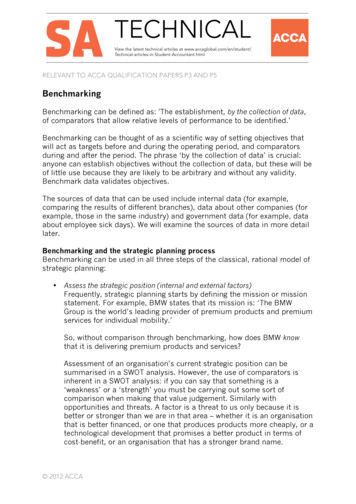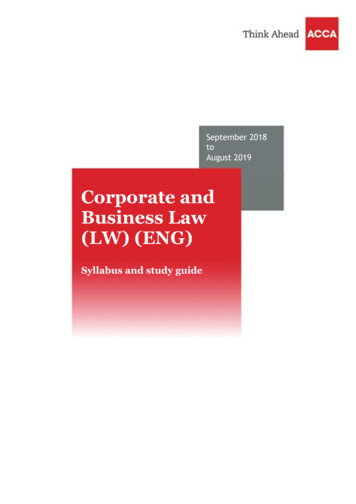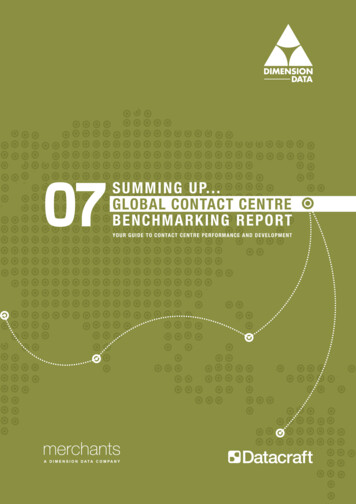
Transcription
RELEVANT TO ACCA QUALIFICATION PAPERS P3 AND P5BenchmarkingBenchmarking can be defined as: 'The establishment, by the collection of data,of comparators that allow relative levels of performance to be identified.’Benchmarking can be thought of as a scientific way of setting objectives thatwill act as targets before and during the operating period, and comparatorsduring and after the period. The phrase ‘by the collection of data’ is crucial:anyone can establish objectives without the collection of data, but these will beof little use because they are likely to be arbitrary and without any validity.Benchmark data validates objectives.The sources of data that can be used include internal data (for example,comparing the results of different branches), data about other companies (forexample, those in the same industry) and government data (for example, dataabout employee sick days). We will examine the sources of data in more detaillater.Benchmarking and the strategic planning processBenchmarking can be used in all three steps of the classical, rational model ofstrategic planning: Assess the strategic position (internal and external factors)Frequently, strategic planning starts by defining the mission or missionstatement. For example, BMW states that its mission is: ‘The BMWGroup is the world’s leading provider of premium products and premiumservices for individual mobility.’So, without comparison through benchmarking, how does BMW knowthat it is delivering premium products and services?Assessment of an organisation’s current strategic position can besummarised in a SWOT analysis. However, the use of comparators isinherent in a SWOT analysis: if you can say that something is a‘weakness’ or a ‘strength’ you must be carrying out some sort ofcomparison when making that value judgement. Similarly withopportunities and threats. A factor is a threat to us only because it isbetter or stronger than we are in that area – whether it is an organisationthat is better financed, or one that produces products more cheaply, or atechnological development that promises a better product in terms ofcost-benefit, or an organisation that has a stronger brand name. 2012 ACCA
2BENCHMARKINGAPRIL 2012Note that a benchmarking exercise can also highlight where acompetitor’s performance is weaker and so point out the areas wherethat competitor is vulnerable and might be fruitfully attacked. Forexample, if it is found that the quality and reliability of a competitor’sproducts are inferior to one’s own products, then an advertisingcampaign emphasising quality of our products could be effective.In all cases, the SWOT analysis should be based as far as possible onfacts; data that has been collected and transformed into benchmarkstandards. Consider strategies and make choicesChosen strategies are those that should lead to competitive advantage.According to Michael Porter, competitive advantage can be obtainedthrough either cost leadership or differentiation (each with or withoutfocus). If cost leadership is to be attained, then an organisation mustknow what costs it needs to beat. What are competitors’ costs? What arethe benchmarks for cost leadership? If the organisation has little hope ofequalling or bettering those costs, then cost leadership is not a sensiblestrategy to attempt.Similarly with differentiation. This strategy is always more complex thancost leadership, where the main criterion is simply to lower unit costswhile maintaining average quality. Differentiation, however, can beattained in a multitude of ways: quality, brand, style, innovation.Whatever the secret of differentiation is, it must be something that beatsthe competition – better quality, stronger brand attributes, better styleor more radical innovation. Once again, measuring how competitorsperform in these metrics is essential. Strategic implementation (strategy into action)Setting objectives is a major tool for implementing a strategy. Strategicplans are often communicated by issuing budgets to divisions,departments and individuals and, of course, budgets consist ofobjectives or targets. However, budgets have to be both challenging (tostay competitive and generate motivation) and attainable (to be takenseriously). Once again, an assessment of potential attainability should bebased on the results that other organisations achieve, and so budgettargets need to be benchmarked against these.Therefore, benchmarking can be used to:(i) push people in the directions where improvement is required(ii) provide measures as to whether that required performance has beenattained or to indicate what improvement is still needed. 2012 ACCA
3BENCHMARKINGAPRIL 2012Types of benchmarkThere are a number of different ways in which benchmarks can be established.A common categorisation of the approaches is as follows: Internal benchmarking. This does not mean simply inventing anobjective internally out of thin air because benchmarking impliescomparison. Internal benchmarks are likely to be set by looking athistorical performance or performances achieved by different branchesor divisions. If last period’s actual results showed that it took 12 minutesto produce each unit, then it might be valid to set a benchmark of 11.5minutes for the next period. Similarly, if the best branch achieved a netprofit percentage of 15%, then that might be a valid target to set allbranches.The potential danger with these approaches is that they are bothinward-looking. Therefore:(i) no attention has been paid to what other organisations, such ascompetitors, are achieving. Note that Porter talks of the need to achievecompetitive advantage. It’s all very well saying that our best branchachieves 15% net profit, but what if competitors routinely achieve 18%?Similarly, last year’s production time of 12 minutes might be way inexcess of more efficient producers(ii) additionally, the opportunities for learning are small. If anorganisation does not realise that competitors are better, not only is thatdangerous in itself, but the organisation will never be inspired to try tofind out how competitors do better.However, internal benchmarking can have advantages, such as:(i) access to the required data should be quick, easy and cheap(ii) it might be the only method if there are no external suitablecompanies for comparison(iii) it might be the only approach possible where other companies’ datais confidential and difficult to obtain. Industry benchmarking. In this approach, benchmarks are set by lookingat what other organisations in the same industry achieve. Industrybenchmarking can be divided into:(i) non-competitor benchmarking(ii) competitor benchmarking.Example of non-competitor benchmarking can be seen in comparingtreatment results for hospitals in different towns, the efficiency ofrubbish collection by different local authorities and the exam success ofchildren in different schools. Because the different organisations are notin competition, the exchange of data should be relatively open, though 2012 ACCA
4BENCHMARKINGAPRIL 2012an organisation that thinks it is performing poorly might be reluctant torelease its data. Therefore, governments often insist that stateenterprises, such as schools or hospitals, publish statistics as it isrecognised that this is important information for managers, staff, usersof the facilities and government. The hope is that by publishing the data,poorer performers will be motivated to improve their game and to learnfrom good performers.Examples of competitor benchmarking can be seen in aircraft turnroundtimes (how long the aircraft is on the ground between flights) and theload factor (what percentage of seats are occupied) for different airlines.Both of these are relatively easy to measure because they are very visibleand you can be sure that airlines keep a close watch on theircompetitors’ statistics. However, you will appreciate that many of themost interesting pieces of data about a competitor will not be easilyaccessible and that competitors will often try to keep this informationconfidential to try to maintain their own competitive advantage.Manufacturing companies sometimes use reverse engineering to attemptto calculate competitors’ costs. It is common, for example, for carcompanies to buy a competitor’s new model and to dismantle it carefullyas the basis for estimating production costs and time.Although industry benchmarking might seem to be almost foolproof,there is a danger that benchmarks are inappropriate becausecomparisons are made with the wrong organisation or because noallowance has been made for important differences. Therefore, whencomparing the performance of children in schools, it would probably bevalid to make allowance for schools in different parts of town. A school ina relatively rich area where many parents are well-educated andsupportive of their children might be expected to outperform a school ina poorer area. In addition, an organisation might not be perceived as acompetitor (and therefore not used for benchmarking) when in fact it isin competition. For example, there is no point in being a really efficientproducer of inexpensive stand-alone digital cameras when that market isbeing supplanted by the increasing quality of cameras in mobile phones.Similarly, the exercise would be of limited use in comparing the costs ofcustomer interactions in a traditional bank with those of a purely onlinebank.Sometimes, organisations in a particular sector set up collaborativebenchmarking. Data can be shared either openly (where there is nocompetition) or anonymously (where there is competition) so that thewhole industry can make use of the data to improve. Thus, in the UKeach year the Department for Business, Innovation and Skills (agovernment department) publishes key performance indicator data 2012 ACCA
5BENCHMARKINGAPRIL 2012(around 700 datasets) for the construction industry. Each company willbe able to recognise its own data and therefore judge how it isperforming relatively. Best-in-class benchmarking. In this approach, rather than comparingentire organisations, the individual activities of an organisation arecompared to those activities in other organisations where the activitiesare carried out really well. So, it would be valid for a telephone-basedbank to compare its call answering times to those in an organisation in adifferent sector that had a very good reputation in dealing promptly withphone calls. From a pricing perspective, a hotel business might learn alot from studying how airlines change their fares in response to demand.Both hotel room vacancies and unoccupied aircraft seats are perishablecommodities and maximising profits in both industries depends onenticing in the last guest or traveller at the maximum marginal revenue.One of the most famous examples of best-in-class benchmarking is thatof airlines improving their turnaround times by benchmarkingthemselves against Formula One racing car pit-stop operations. In bothcases, there will be both routine operations to be carried out efficientlyand occasional emergency or unexpected repairs and replacements ofcomponents. Well-trained teams, spares inventories, technicianavailability will be essential to the success of both operations.The great strength of best-in-class benchmarking is the high degree oflearning that is encouraged. The observation of very successfulprocesses and activities, wherever found, will often generate radicalinnovation and improvement in an organisation’s competitive strength.Furthermore, very good performance in one aspect of a certain industry,perhaps a very slick website in a travel site, is likely to raise customers’expectations in many different industries, so that slick websites areexpected everywhere.What should be benchmarked?Priority should be given to benchmarking performance areas that result in anorganisation’s success. As mentioned above, an organisation’s success shouldbe defined by its mission, and ambitions stated there should be benchmarked.So, BMW needs to devise measurements that address its mission to makepremium products and to deliver premium services, and then must compareits performance to that of companies like Mercedes (same industry) andperhaps to a company such as Amazon for customer service and delivery ofspares and accessories.In profit-seeking organisations competitive advantage can be achieved eitherby cost leadership or differentiation. If cost leadership is the generic strategy 2012 ACCA
6BENCHMARKINGAPRIL 2012adopted by a supermarket, then the following might be worth benchmarkingagainst competitors: Turnover/employment costs Shop rent/m2 Inventory turnover Inventory costs Wastage Number of inventory lines stocked (keep low to minimise costs) Gross profit percentageIf, however, the supermarket attempted to compete through differentiation andpresented itself as an upmarket brand, then the following might be particularlyworth benchmarking: Number of inventory lines stocked (keep high to offer choice) Number of new products brought to market Number of unique products Gross profit percentage Check-out queuing times Customers’ impressions of quality.Of course, this is not to say that the upmarket supermarket would not careabout wastage and so on, but a cost leader lives or dies by keeping costs verylow while a differentiator depends on high levels of service, innovation,uniqueness, style and quality.Another approach that can indicate where benchmarking would be particularlyuseful is to examine an organisation’s value chain. Porter set this out asfollows:Firm infrastructureMargin/profitTechnology developmentSupportactivitiesHuman resources boundlogisticsSales andmarketingServicePrimary activitiesThe rationale behind the value chain is that, as a result of an organisationspending time, money and effort carrying out the various activities, theorganisation manages to make a profit. In other words, customers ar
In all cases, the SWOT analysis should be based as far as possible on facts; data that has been collected and transformed into benchmark standards. Consider strategies and make choices Chosen strategies are those that should lead to competitive advantage. According to











